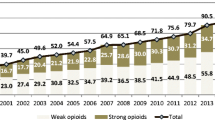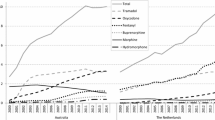Abstract
Background
Opioid analgesics play a unique role in pain management. National opioid consumption studies could provide indirect evidence of pain management in a country. National, regional, and global opioid consumption have been studied in other countries so far; however, conducting a focused study to illuminate the consumption of opioid analgesics over the past decades in Iran seemed necessary.
Aim
The main objective of this study was to determine the consumption of opioid analgesics and explore the trend of their use during 19 years in Iran.
Method
Iran pharmaceutical wholesale data were used to extract the annual consumption figures of the opioid analgesics in group N02A of the World Health Organization (WHO) Anatomical Therapeutic Chemical classification and were available in Iran (morphine, fentanyl, pethidine, and oxycodone as strong opioids and, tramadol and pentazocine as weak opioids), from 2000 to 2018. Using Defined Daily Dose (DDD) by WHO and Oral Morphine Equivalent (OMEQ), the amount of annual consumption was determined in DDD/1000 inhabitants/Day (DID) and OMEQ (mg)/1000 inhabitants/Day (OID).
Results
Total opioid analgesic utilization based on DID and OID increased 31.12-fold (from 0.0196 to 0.61) and 21.06-fold (from 1.97 to 41.5 mg) over 19 years, respectively with a significant sharp increase from 2003 to 2006 (ß = 1.78 (DID), P value < 0.001). Medications that constituted 70% of annual opioid analgesics utilization were morphine in 2000, compared to tramadol in 2018. The annual weak and strong opioids share were 86.7% and 13.2% in 2018, respectively.
Conclusion
Despite considerable growth in the consumption of opioid analgesics in Iran over nearly two decades, the consumption amount remained low, which might signal sub-optimal pain management. On the other hand, misuse and abuse seem to be the main reason behind significant increases in the consumption of opioid analgesics with less controlled distribution.





Similar content being viewed by others
References
Goldberg DS, McGee SJ. Pain as a global public health priority. BMC Public Health. 2011;11(1):770.
Cheatle MD. Facing the challenge of pain management and opioid misuse, abuse and opioid-related fatalities. Expert Rev Clin Pharmacol. 2016;9(6):751–4.
Kuehn BM. Opioid prescriptions soar. JAMA. 2007;297(3):249–51.
Alenezi A, Yahyouche A, Paudyal V. Current status of opioid epidemic in the United Kingdom and strategies for treatment optimisation in chronic pain. Int J Clin Pharm. 2021;43(2):318–22.
Paice JA, Von Roenn JH. Under- or overtreatment of pain in the patient with cancer: how to achieve proper balance. J Clin Oncol. 2014;32(16):1721–6.
Morriss WW, Roques CJ. Pain management in low- and middle-income countries. BJA Educ. 2018;18(9):265–70.
Scholten W, Christensen AE, Olesen AE, et al. Analyzing and benchmarking global consumption statistics for opioid analgesics 2015: inequality continues to increase. J Pain Palliat Care Pharmacother. 2020;34(1):1–12.
World Health Organization. Ensuring balance in national policies on controlled substances: guidance for availability and accessibility of controlled medicines. Geneva: World Health Organization; 2011.
O’Brien T, Christrup LL, Drewes AM, et al. European Pain Federation position paper on appropriate opioid use in chronic pain management. Eur J Pain. 2017;21(1):3–19.
Sheridan JL. Overview of this issue: “Pain management in an opioid crisis.” Int J Clin Pharm. 2021;43(2):309–12.
Fredheim OM, Skurtveit S, Breivik H, et al. Increasing use of opioids from 2004 to 2007—pharmacoepidemiological data from a complete national prescription database in Norway. Eur J Pain. 2010;14(3):289–94.
Karanges EA, Blanch B, Buckley NA, et al. Twenty-five years of prescription opioid use in Australia: a whole-of-population analysis using pharmaceutical claims. Br J Clin Pharmacol. 2016;82(1):255–67.
Del Pozo JG, Carvajal A, Viloria JM, et al. Trends in the consumption of opioid analgesics in Spain. Higher increases as fentanyl replaces morphine. Eur J Clin Pharmacol. 2008;64(4):411–5.
Hudec R, Tisoňová J, Božeková L, et al. Trends in consumption of opioid analgesics in Slovak Republic during 1998–2002. Eur J Clin Pharmacol. 2004;60(6):445–8.
Fang W, Liu T, Gu Z, et al. Consumption trend and prescription pattern of opioid analgesics in China from 2006 to 2015. Eur J Hosp Pharm. 2019;26(3):140–5.
Hamunen K, Paakkari P, Kalso E. Trends in opioid consumption in the Nordic countries 2002–2006. Eur J Pain. 2009;13(9):954–62.
Kang K-H, Kuo L-F, Cheng IC, et al. Trends in major opioid analgesic consumption in Taiwan, 2002–2014. J Formos Med Assoc. 2017;116(7):529–35.
De Conno F, Ripamonti C, Brunelli C. Opioid purchases and expenditure in nine western European countries: ‘Are we killing off morphine?’ Palliat Med. 2005;19(3):179–84.
Jones W, Kaoser R, Fischer B. Patterns, trends and determinants of medical opioid utilization in Canada 2005–2020: characterizing an era of intensive rise and fall. Subst Abuse Treat Prev Policy. 2021;16(1):65.
Berterame S, Erthal J, Thomas J, et al. Use of and barriers to access to opioid analgesics: a worldwide, regional, and national study. The Lancet. 2016;387(10028):1644–56.
Jayawardana S, Forman R, Johnston-Webber C, et al. Global consumption of prescription opioid analgesics between 2009–2019: a country-level observational study. EClinicalMedicine. 2021;42:101198.
Taheri F. Patterns and trends in opioid use in Iran from 2007 to 2011. Value Health. 2014;17(7):A539.
Kebriaeezadeh A, Eslamitabar S, Kahtibi M. Iranian pharmaceutical laws and regulations. Tehran: Razi Distribution Co.; 2008.
Zaboli P, Hashemi-Meshkini A, Varmaghani M, et al. Pharmaceutical laws and regulations in Iran: an overview. J Res Pharm Pract. 2016;5(3):155–61.
ATC/DDD Index. WHO Collaborating Centre for Drug Statistics Methodology. 2018. https://www.whocc.no/atc_ddd_index/. Accessed 20 Aug 2018.
Jarlbaek L, Andersen M, Hallas J, et al. Use of opioids in a Danish population-based cohort of cancer patients. J Pain Symptom Manag. 2005;29(4):336–43.
Svendsen K, Borchgrevink P, Fredheim O, et al. Choosing the unit of measurement counts: the use of oral morphine equivalents in studies of opioid consumption is a useful addition to defined daily doses. Palliat Med. 2011;25(7):725–32.
Islam MM, McRae IS, Mazumdar S, et al. Prescription opioid analgesics for pain management in Australia: 20 years of dispensing. Intern Med J. 2016;46(8):955–63.
Liu X, Luo C, Dai H, et al. Consumption trends and prescription patterns of opioids from 2011 to 2016: a survey in a Chinese city. BMJ Open. 2019;9(3):e021923.
Norris BA, Smith A, Doran S, et al. Trends in strong opioid prescribing in Ireland: a repeated cross-sectional analysis of a national pharmacy claims database between 2010 and 2019. Pharmacoepidemiol Drug Saf. 2021;30(8):1003–11.
Alikiaie B, Mousavi S, Ebrahimi A, et al. Evaluation of pain assessment and management in critically Ill intubated patients in a referral university hospital in Iran. J Res Pharm Pract. 2019;8(3):137–42.
Cyrus A, Moghimi M, Jokar A, et al. Model determination of delayed causes of analgesics prescription in the emergency ward in Arak, Iran. Korean J Pain. 2014;27(2):152–61.
Masoudi Alavi N, Aboutalebi MS, Sadat Z. Pain management of trauma patients in the emergency department: a study in a public hospital in Iran. Int Emerg Nurs. 2017;33:53–8.
Vatanpour H, Soltani M, Sufi H. Drug utilization review of parenteral opioid analgesics in cardiovascular surgery department of Shahid Modarres Hospital, Tehran. Int J Med Res Health Sci. 2016;5(8):181–6.
Vatanpour H, Sufi H, Jomeh NE, et al. Parenteral opioid analgesics utilization pattern in Amir-al-Momenin hospital, Zabol-Iran. Int J Med Res Health Sci. 2016;5(8):112–9.
Vatanpour H, Sufi H, Salamzadeh J, et al. Drug utilization review of parenteral analgesic opioids in Amir-al-momenin hospital at 1390 in Zabol-Iran. Res Pharm Sci. 2012;7(5):931.
Rassouli M, Sajjadi M. Palliative care in Iran: moving toward the development of palliative care for cancer. Am J Hosp Palliat Care. 2016;33(3):240–4.
Hadian M, Jabbari A, Mazaheri E. What must Iran do for Palliative care? A systematized review. J Educ Health Promot. 2020;9:276.
Fallahi S, Rassouli M, Mojen LK. Cultural aspects of palliative cancer care in Iran. Palliat Med Hosp Care Open J. 2017;1:S44-50.
Kheshti R, Namazi S, Mehrabi M, et al. Health care workers’ knowledge, attitude, and practice about chronic pain management, Shiraz. Iran Anesth Pain Med. 2016;6(4):e37270.
Mehrolhassani MH, Yazdi-Feyzabadi V, Hajebi A, et al. Cross-country comparison of treatment policies facing the drug abuse in five selected countries. Addict Health. 2019;11(2):81–92.
Cochran G, Rubinstein J, Bacci JL, et al. Screening community pharmacy patients for risk of prescription opioid misuse. J Addict Med. 2015;9(5):411–6.
Edwards Z, Ziegler L, Craigs C, et al. Pharmacist educational interventions for cancer pain management: a systematic review and meta-analysis. Int J Pharm Pract. 2019;27(4):336–45.
Hadi MA, Alldred DP, Briggs M, et al. Effectiveness of pharmacist-led medication review in chronic pain management: systematic review and meta-analysis. Clin J Pain. 2014;30(11):1006–14.
Savas M, Bayraktar-Ekincioglu A, Celebi N. An evaluation of cancer patients’ opinions about use of opioid analgesics and the role of clinical pharmacist in patient education in Turkey. Int J Clin Pharm. 2021;43(2):375–82.
Alenezi A, Yahyouche A, Paudyal V. Interventions to optimize prescribed medicines and reduce their misuse in chronic non-malignant pain: a systematic review. Eur J Clin Pharmacol. 2021;77(4):467–90.
Jafari M, Ghasemyani S, Khodayari-Zaranq R, et al. Health transformation plan achievements and outcomes in Iran (2014–2020): a scoping review. Med J Islam Repub Iran. 2021;35:151.
Gholami K, Shalviri G, Zarbakhsh A, et al. New guideline for tramadol usage following adverse drug reactions reported to the Iranian pharmacovigilance center. Pharmacoepidemiol Drug Saf. 2007;16(2):229–37.
Rostam-Abadi Y, Gholami J, Amin-Esmaeili M, et al. Tramadol use and public health consequences in Iran: a systematic review and meta-analysis. Addiction. 2020;115(12):2213–42.
Chen T-C, Chen L-C, Knaggs RD. A 15-year overview of increasing tramadol utilisation and associated mortality and the impact of tramadol classification in the United Kingdom. Pharmacoepidemiol Drug Saf. 2018;27(5):487–94.
Nasiri N, Abedi L, Hajebi A, et al. Population size estimation of tramadol misusers in urban population in Iran: synthesis of methods and results. Addict Health. 2019;11(3):173–82.
World Health Organization Expert Committee on Cancer Pain Relief. Cancer pain relief and palliative care: report of a WHO expert committee [meeting held in Geneva from 3 to 10 July 1989]. Geneva: World Health Organization; 1990.
Wagemaakers FN, Hollingworth SA, Kreijkamp-Kaspers S, et al. Opioid analgesic use in Australia and The Netherlands: a cross-country comparison. Int J Clin Pharm. 2017;39(4):874–80.
Schmidt-Hansen M, Bennett MI, Arnold S, et al. Oxycodone for cancer-related pain. Cochrane Database Syst Rev. 2022;6(6):Cd003870.
Dhalla IA, Mamdani MM, Sivilotti MLA, et al. Prescribing of opioid analgesics and related mortality before and after the introduction of long-acting oxycodone. Can Med Assoc J. 2009;181(12):891.
Remillard D, Kaye AD, McAnally H. Oxycodone’s unparalleled addictive potential: is it time for a moratorium? Curr Pain Headache Rep. 2019;23(2):15.
Soeiro T, Pradel V, Lapeyre-Mestre M, et al. Evolution of doctor shopping for oxycodone in the 67 million inhabitants in France as a proxy for potential misuse or abuse. Pain. 2021;162(3):770–7.
Knaul FM, Farmer PE, Krakauer EL, et al. Alleviating the access abyss in palliative care and pain relief-an imperative of universal health coverage: the Lancet Commission report. Lancet. 2018;391(10128):1391–454.
Bhadelia A, De Lima L, Arreola-Ornelas H, et al. Solving the global crisis in access to pain relief: lessons from country actions. Am J Public Health. 2019;109(1):58–60.
Funding
The Research Council of Tehran University of Medical Sciences supported this study (Grant Number: 97-03-156-40703).
Author information
Authors and Affiliations
Corresponding author
Ethics declarations
Conflicts of interest
The authors have no relevant financial or non-financial interests to disclose.
Additional information
Publisher's Note
Springer Nature remains neutral with regard to jurisdictional claims in published maps and institutional affiliations.
Supplementary Information
Below is the link to the electronic supplementary material.
Rights and permissions
Springer Nature or its licensor (e.g. a society or other partner) holds exclusive rights to this article under a publishing agreement with the author(s) or other rightsholder(s); author self-archiving of the accepted manuscript version of this article is solely governed by the terms of such publishing agreement and applicable law.
About this article
Cite this article
Kalantar, A., Rezaei, M., Jafarzadeh Kohneloo, A. et al. A nationwide study on consumption of opioid analgesics in Iran from 2000 to 2018. Int J Clin Pharm 45, 397–405 (2023). https://doi.org/10.1007/s11096-022-01518-0
Received:
Accepted:
Published:
Issue Date:
DOI: https://doi.org/10.1007/s11096-022-01518-0




